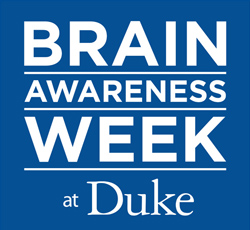By Ashley Mooney
Hearing music and moving to it are more connected than you’d think.
Neurobiologists have traditionally viewed human responses to sound as reflexive.
But in fact, perception of sound and music can be viewed as much more dynamic, said Richard Mooney, George Barth Geller professor of neurobiology and classically-trained guitarist. Rather than speaking in a typical lecture hall, Mooney presented his research in Motorco Music Hall.
“In the classic view of how the nervous system works, there’s a sensory stimulus in the world that excites our sensory receptors and then we behave,” Mooney said. “This can’t be so. We don’t live in a reflexive experience. We’re living in a state where we’re present in the moment.”
Using a video of musician Jimi Hendrix’s performance of “Johnny B. Goode,” Mooney illustrated the connection between the motor system and the auditory cortex.
“Hendrix is anticipating all these dynamics in music, moving his body in a way to accentuate it,” Mooney said. “It’s a really good example of how our brain must be forecasting the sound it wants to make or the sound it wants to experience.”
Mooney cited a study in which trained keyboard players were asked either to listen to music without making physical movements or to play a piece without being able to hear it. Using functional MRI, researchers found that the auditory cortex, the supplementary motor area and the premotor cortex of the brain all receive more oxygen than other sections during either task, implying a connection between the systems.
“Music isn’t passive. Even when we’re listening, it’s engaging not only the biological amplifier in our ear, but also this really complex network of sensory motor structures in our brain,” Mooney said.
A part of the inner ear called the cochlea functions as an acoustical prism, splitting complex sounds into an array of simpler, tone-like components.
“The lens of our eye focuses stimuli in a way that’s Cartesian,” Mooney said. “In contrast, what our ear has to do is really take a mismatched pattern of energy that’s vibrating in our eardrum and decompose it into simpler components.”
People have biological amplifiers deep in their cochlea that allow them to perceive and interpret speech and music. Average-volume speech usually causes the basilar membrane, a structure in the inner ear, to vibrate within a very small distance—approximately the diameter of a gold atom. Mooney noted that the level of vibration indicates that the membrane moves about 100-fold more than it would if the system were purely passive.
The cochlea even vibrates in deaf ears, just not to the same extent. But much of a person’s ability to hear, that is to discern differences in pitch and the nuances of spoken language, also rely on hair cells within the ear.
“These aren’t the things responsible for your grandfather’s tufts of hair that are coming out of his ears,” Mooney said. “These are all a special kind of nerve cell called a receptor cell.”
Even though all people have connections between their motor and auditory systems and may understand the connections conceptually, musicians and those who frequently practice making music can usually predict upcoming tones with more accuracy.
He provided the example of basketball players shooting free throws. If shown video clips of a person shooting a free throw, but not the final trajectory, only professional players can accurately predict whether the ball went into the basket. Sportscasters and audience members cannot accurately predict baskets, even if they are highly exposed to watching the actions.
 The lecture was part of Brain Awareness Week, a global campaign to encourage public interest in the progress and benefits of brain research. Mooney noted that Brain Awareness Week helps him gain a different perspective on his research.
The lecture was part of Brain Awareness Week, a global campaign to encourage public interest in the progress and benefits of brain research. Mooney noted that Brain Awareness Week helps him gain a different perspective on his research.
“Scientists hang out with themselves in their labs and they ask each other these really sort of pointy headed questions all the time,” he said. “They don’t get a lot of chances to hear from people who have really different perspectives.”
The final event in the series was a hands-on demonstration at the Museum of Life and Science, Saturday from 1 to 4 p.m.


